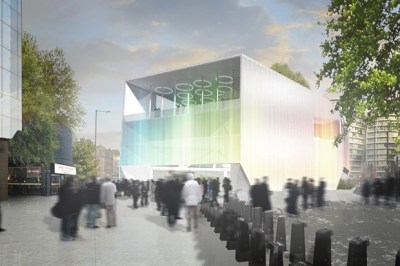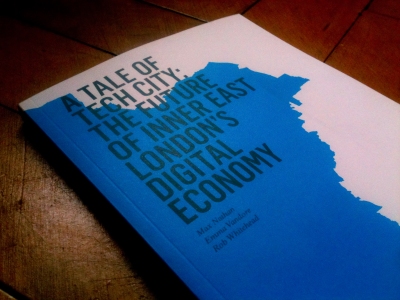
Bonus Levels is a series of beautifully realised recreations of London locations, re-imagined as Ballardian dreamscapes, elements of an impossible city. In After Us, creator Lawrence Lek describes his work as ‘architecture as site-specific simulation’, in which existing parts of the cityscape and its institutions are ‘reconfigured and subverted’ by some apocalyptic or economic shock. I think this can help us think about real-world urban change too. Let’s look at a couple of examples.
*
In ‘Dalston, Mon Amour’, some familiar landmarks of the Kingsland Road – the Rio Cinema, Gillett Square and once on-trend Efes Bar are rendered empty and open to the elements after a biblical weather event. Terraformed by desert and water, Renais’ film plays in the background as the sky darkens.

You can certainly treat this work as satirical – hipster touchstones crumbled into dust – and Lek is clear that this is part of the point. The use of video game aesthetics is also nice, although as Lek points out, ‘the player begins when the game is already over’: it’s first-person flaneur. The game framing also exacerbates the dreamlike quality of each episode – background sounds pan around, and there are sudden changes in perspective or time of day.
There’s also a deeper, uncanny power to it. Places we knew and hold dear, transformed into dreamspaces. As Adam points out, Vermilion Sands, The Sprawl or De Chirico are never far away. But also – for some viewers – their own memories are reconfigured. As Lek argues, the more time you spend in each episode, the more meaning your own mind layers over it.
*
I experienced a real-world retelling of my own world a few months back, in farcical form, as a group of us were taken on a guided tour of ’Silicon Roundabout and Tech City’. The tour had felt like a good idea as part of a new paper we’ve been writing on the East London tech scene: in practice it involved much psychodrama.
As the tour went on, for example, I was alarmed to find that the guide’s spiel included numerous factoids taken from my own research, fed back in slightly distorted form. Even worse, as we left Old St roundabout we were taken to the Foundry, a now-deceased bar and venue my friends and I spent much time in during years gone by, and which was shut down amid much protest. The guide described it as an ‘important cultural institution throughout the 90s and some of the 00s’: opening up a chasm of lost time in the process. The site now houses the Hoxton Pastry Union, an almost comically resonant symbol of the changes the neighbourhood has since gone through.
Sharing this moment with friends afterwards, it became clear what a powerful charge it packed.

A more formal way to think about Lek’s project is a series of spatial imaginaries, Bob Jessop’s term for the mental maps we all use to get purchase on everyday life. More formally, Jessop means imaginaries to act as mapping systems or ‘fixes’ that allow agents to navigate otherwise impossibly complex late capitalism.
Imaginaries – like Silicon Roundabout / Tech City itself – are necessarily partial, pushing some elements to the fore and ignoring others. They are thus ripe for the kind of reconfiguring and questioning Lek engages in.
Part of the paper I’m working on looks at Here East, the vast Olympic Broadcast and Media Centre which is being rapidly transformed into a new, maker-focused neighbourhood. On a recent visit the site was still under construction, but we got a clear sense of the developers’ vision.

Notice how the rebrand involves both a new name, a new industrial niche, and a spatial repositioning of the site, away from Stratford and into Hackney, specifically the artist-centric milieu of Hackney Wick which sits just over the canal.
*
I was happy to see that Bonus Levels has also engaged with this territory. ‘Delirious New Wick’ is a hysterical rebuild of E9 and the Olympic Park, in which the Games’ iconic structures float above the park and are accessed through teleporters. A gorgeous Burial soundtrack runs in the background as we float high above the city, before descending onto the ruins of the Westfield mall, now partially submerged in an Arthurian Lake. It is heady, brilliant stuff.









